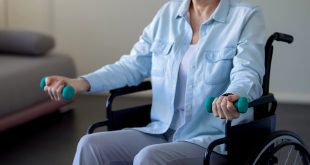By now you’ve no doubt heard that sitting is bad for you. But wait, you exercise so you needn’t worry about the harms of sedentary living, right? Well, you might want to stand up, because I have something worrisome to tell you. A growing body of research shows that people who spend many hours of the day sitting die at an earlier age than those who sit less – even if those sitters exercise.
Numerous studies report that prolonged sitting is strongly associated with obesity, abnormal metabolism, diabetes, metabolic syndrome, cardiovascular disease, cancer and an increased risk of early death. That’s quite a list. And surprisingly, these risks still exist if you exercise daily. So, even if you run for an hour each day, but sit at a desk for eight hours, and then sit in front of the TV or the computer for another three hours, you’re still at risk for developing these conditions.
A study from the University of Texas Southwest Medical Center explains the negative impact of sitting for runners. Running for an hour, in addition to the standard 10 hours of sitting during the day, equates to an 80% loss of running’s health benefits. It diminishes the run’s hourly benefits down to a mere 12 minutes. Imagine the negative effects if you don’t exercise at all.
In fact, regular exercisers may make less of an effort to move outside their designated workout time. Maybe they think they’ve worked out enough for one day. However, some studies have shown that higher levels of regular exercise can decrease the health risks from sitting. A meta-analysis published in the Annals of Internal Medicine found that the harmful effects of sedentary time generally decreased in people with higher levels of physical activity; these levels would equate to between six and 10 hours of brisk walking each week. A recent study published in The Lancet reported that there was no increased risk of death in those who sat for more than eight hours per day, but who also reported activity levels equivalent to more than 11 hours per week of brisk walking. However, this high activity level but did not eliminate the increased risk associated with high TV-viewing time.
As usual, the literature seems conflicting. But I don’t think that there is any disagreement that sitting is harmful. It causes several physiological changes in the body that can negatively affect your organs, muscles, enzymes, hormones, circulation, metabolism and bones. These effects can start after only 15 minutes of sitting. The good news is that normal function can be restored by getting up for just five or 10 minutes. The muscle activity needed for standing and other movement seems to trigger important processes within the body. When you sit, these processes stall — and your health risks increase. When you’re standing or actively moving, you kick the processes back into action. Click here to read a really neat summary of this principle.
But don’t buy your standing desk quite yet. While it’s clear that a sedentary lifestyle is bad for you, you can’t just all of a sudden take away people’s chairs. Prolonged standing also leads to its own set of problems, including chronic venous insufficiency, lower back pain, muscle and bone problems of the feet, preterm birth and spontaneous abortion. So where does this leave us? Lying down?
And to confuse things further, you may have read in the headlines recently that “sitting time is not associated with all-cause mortality risk.” I think this is misleading because what the study being reported did find was that the absence of movement causes health problems, rather than the time spent sitting itself. To me, sitting implies a lack of movement. But the study challenges the benefits of standing because the researchers found that any stationary posture where energy expenditure is low may be detrimental to people’s health, whether they’re sitting or standing.
Standardized sitting guidelines have not yet been established, but some experts have suggestions for employers to promote the avoidance of prolonged periods of sedentary work. For those occupations that are predominantly desk-based, workers should aim progressively toward accumulating two hours per day of standing and light activity (light walking) during working hours, eventually building up to a total of four hours per day. To achieve this, seated-based work should be regularly broken up with standing-based work, the use of sit–stand desks, or short active standing breaks.
Here are some tips for home and work:
- Spend some time every day tidying up. This will get you off the couch and free up some time to do something active on the weekend.
- Stretch or do some squats while you watch TV. If you must sit, sit on an exercise ball. When you watch TV, make an effort to get up and move during commercial breaks.
- Exercise your calf muscles while brushing your teeth. Place your feet flat on the floor, then rise up onto the balls of your feet, hold for two seconds, then sink down. Repeat until you’re done brushing. You can also do this exercise while washing dishes or standing in line.
- If you have children, take advantage of their sports practices to be active. You are not a bad parent if you don’t watch an entire practice or game!
- When you’re talking on the telephone, stand up and, if possible, walk or pace. Never stay seated while chatting on the phone.
- Have walking meetings.
- Get up from your desk and do some stretches.
- Instead of e-mailing or calling colleagues, walk to their part of the building for some face time when you need to ask a question or solve a work issue.
- Give up your seat on public transit. If you prefer to sit and read (or sleep), get up a stop earlier and make your way to the door.
- Set goals for the amount of time spent sitting.
- Set alarms for when to stand and move around.
- Record sitting times.
Unfortunately, most sedentary workers have limited opportunities for movement, or they become so preoccupied in their work that hours slip by before realizing they have not moved a muscle. Remaining immobile for durations exceeding 15 minutes adds up to some very nasty health outcomes. Any movement, from fidgeting to desk stretches, is beneficial in keeping health risks at bay. The key messages are simple: move more during the day, and move as much as possible.
 Diabetes Care Community Learn, connect and care
Diabetes Care Community Learn, connect and care



